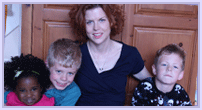Book Review: The Joy Luck Club by Amy Tan
 The Joy Luck Club by Amy Tan
The Joy Luck Club by Amy Tan
First published in 1989
My rating: 4 of 5 stars
Publisher’s Description:
Four mothers, four daughters, four families whose histories shift with the four winds depending on who’s “saying” the stories. In 1949 four Chinese women, recent immigrants to San Francisco, begin meeting to eat dim sum, play mahjong, and talk. United in shared unspeakable loss and hope, they call themselves the Joy Luck Club. Rather than sink into tragedy, they choose to gather to raise their spirits and money. “To despair was to wish back for something already lost. Or to prolong what was already unbearable.” Forty years later the stories and history continue.
With wit and sensitivity, Amy Tan examines the sometimes painful, often tender, and always deep connection between mothers and daughters. As each woman reveals her secrets, trying to unravel the truth about her life, the strings become more tangled, more entwined. Mothers boast or despair over daughters, and daughters roll their eyes even as they feel the inextricable tightening of their matriarchal ties. Tan is an astute storyteller, enticing readers to immerse themselves into these lives of complexity and mystery.
The Joy Luck Club is about four Chinese mothers who play mahjong together and their daughters. At the beginning of the book, one of the mothers has passed away and the club invites her daughter to take her spot. This book isn’t one continuous narrative. There are sixteen vignettes that are interwoven with each other. They provide a glimpse into the pasts of each woman which sheds light on why they are the way they are in the present day. The mothers all have some sort of hardship or tragedy in their pasts that have informed how they parented their daughters. Unfortunately, because of their culture, they are either vague or downright secretive about what has happened to them, which causes harm to their relationships with their daughters.
I enjoyed that this book was told from multiple perspectives. I like learning the motivation behind each character’s choices. The way it was structured allowed every woman’s character to be well-developed. I did have some trouble keeping track of which daughter belonged to which mother but luckily there is a handy dandy chart in the front of the book to help with that. Now that I’ve read the book, I want to see the movie, which I’ve heard is really good. I know I’m a little late to the party on that – the movie was released in 1993!




